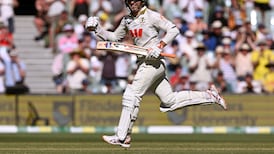For many years the GAA regarded publicity as a kind of problem which was containable if not completely at variance with its aims. When 2RN, the forerunner of RTE, first broadcast a radio commentary on the All-Ireland hurling semi-final of 1925 between Kilkenny and Galway, there were grave reservations about whether such coverage was good or bad for the association.
The commentator on that particular match was P D Mehigan, late of this parish. The inspirational idealist of this project was P S O'Hegarty, the then secretary of the Department of Posts and Telegraphs and, as they say, the rest is history.
Mehigan, many years later recalled that momentous occasion vividly. He wrote: "I inspected all the contraptions and wires and earphones in the office underneath the Hogan Stand. Then a big square mahogany box with wires and screws and gadgets was set out and I was asked to sit beside the box.
"A leather contraption was put around my neck with a yellow brass tube put in front of me. It was all new to me; I had just my teams on a slip of paper in my hand."
Later he was to experience the down-side of this experiment. He wrote: "Then there was the very earnest GAA man who loudly proclaimed to all around him: "If they don't take than bl . . . y box out of Croke Park they might as well close the gates."
The then president of the GAA, William Clifford of Limerick, told Mehigan: "These broadcasts of yours are worth a thousand pounds a year to the GAA as publicity." Apparently there were both begrudgers and visionaries even then.
In the meantime there have been many occasions when the gates of Croke Park have been closed - not because nobody was willing to turn up but because the games have become more and more popular.
All of which is by way of paying tribute to the 40th anniversary of the magazine Gaelic Sport which is being celebrated in its latest edition.
When it was neither popular nor profitable, the editor Tommy McQuaid, with determination and consistency, produced a magazine of some style and importance which has given sterling service to the GAA and to those of us who labour in the field of sports journalism. A man of great modesty as well as knowledge, Tommy McQuaid, has done a signal service to the GAA in particular and to sporting journalism in general. It may very well be that the controversies within the GAA, both on and off the field, were not always highlighted but the love for the games always prevailed and continues to do so in the magazine.
This space could not cope with the plethora of articles which are included in this celebratory edition. Some names stand out - Jimmy Barry Murphy, Brian Whelehan, Joe Brolly, Mattie McDonagh, Mickey Kearns, Eddie Keher, Jamsie O'Connor, Mick O'Connell - the list seems endless.
Not surprisingly, Mick O'Connell throws in a thoughtful and, at he same time, controversial statement thus: "If handpassing had been in vogue in my young days it is doubtful if I would have played it at all. It is NOT a skill. Good kicking of the ball, off hands or ground, is a real football skill."
Since Gaelic Sport was first published 40 years ago, much has changed in Ireland and in the GAA. What remains constant, however, is that there is a deeply held commitment in all areas of Irish life to the games which are part of our heritage and this is, surely, epitomised in the current edition of the magazine.
Needless to say the names of Paddy Downey and Mick Dunne appear prominently. They have both contributed enormously to the coverage of Gaelic games for many years in print and in broadcasting. What the GAA has to admit, dragged screaming (sometimes), into modern life, is that many of those who have been critical of the policy-making procedures and the administration of the games, have always been positively motivated. Publications such as Gaelic Sport and the various newspapers (local and national) have played a major part in the popularity of the games as they stand at present.
This is not always recognised by some of the dinosaurs who still inhabit some of the corridors of power within the GAA on a nationwide basis. One hopes that the recent take-overs of the most famous soccer clubs in Britain by greedy entrepreneurs who care little for sport of any kind but only for personal gain, will serve as a warning that publicity for the GAA's activities is not earned without some acknowledgment of its commercial worth. There remains an antagonism within certain areas of the GAA to the "accursed media" - as it was once forcefully described by a GAA functionary. The loyalty of Gaelic Sport is not unique insofar as coverage of GAA affairs is concerned. It exists in the heartland of GAA activity throughout the 32 counties and abroad.
Why then, one must ask, is it that county boards continue to frustrate the efforts of many devoted reporters for local weekly newspapers when they attempt to get team selections in time for their deadlines in midweek? Many local weekly newspapers, who give blanket coverage to GAA affairs, are forced to go to press without team selections on a regular basis. Why is this? Sheer nastiness one might suggest.
But, leaving all that aside, the 40th anniversary of a respected sports magazine gives all of us cause for celebration and a reason to offer Tommy McQuaid and his team our hearty congratulations. Beir beannacht Tomas.










